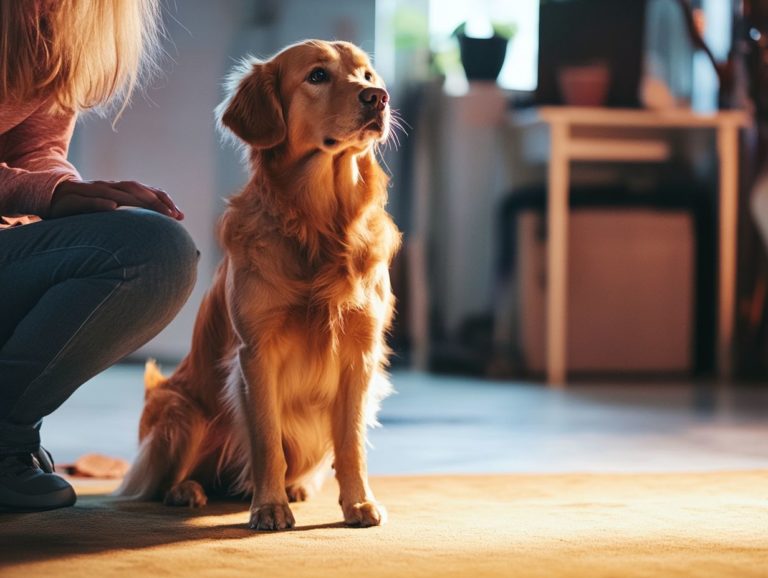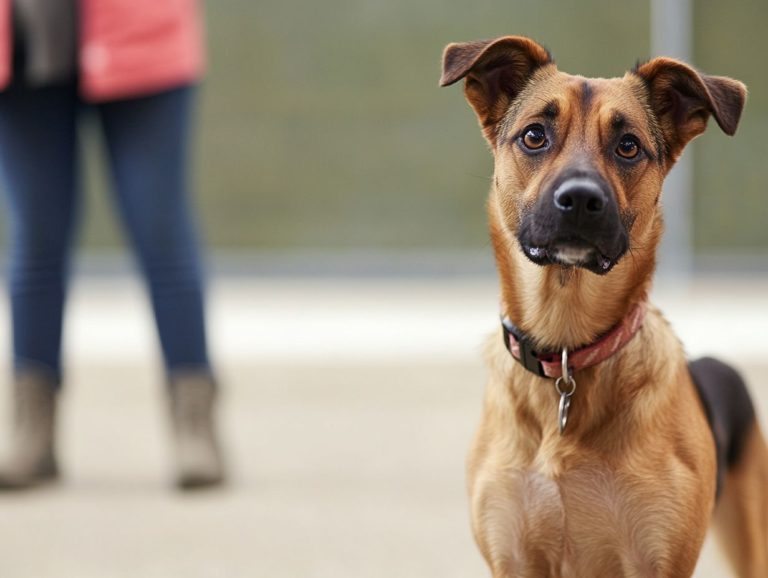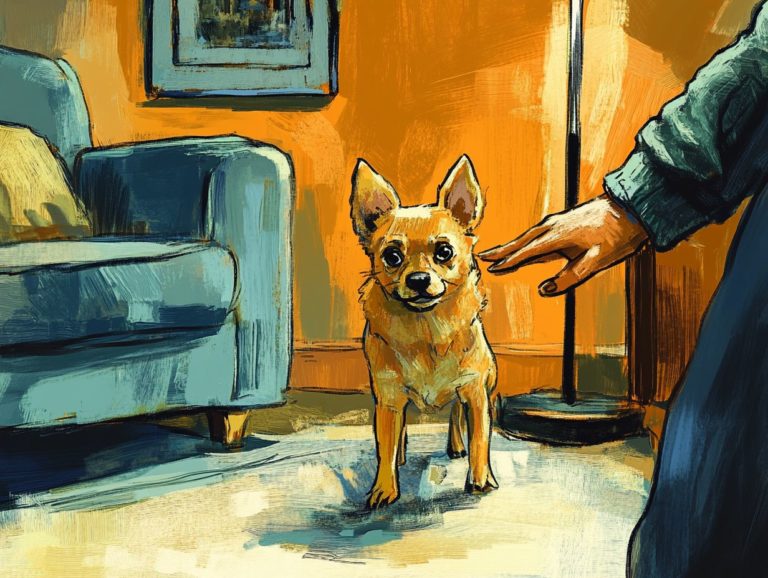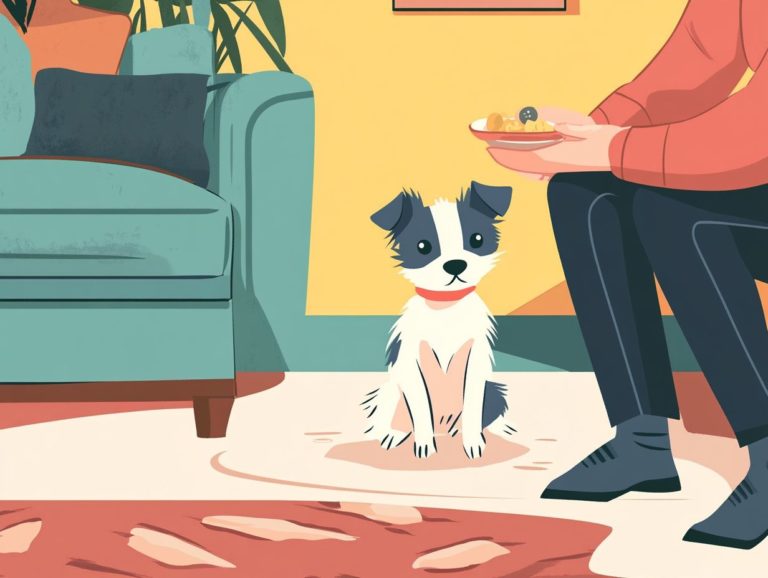How to Use Clicker Training for Anxious Dogs
Anxious dogs often find it challenging to adapt to their environments. Clicker training presents a compassionate and effective solution to help them feel more at ease.
This guide covers the basics of clicker training, explaining how it works and the unique benefits it offers for dogs grappling with anxiety.
You ll uncover practical steps to implement this technique, troubleshoot common hurdles, and seamlessly integrate clicker training into your daily routine.
Watch your dog’s behavior transform with the exciting power of positive reinforcement!
Contents
- Key Takeaways:
- Understanding Clicker Training
- Benefits of Clicker Training for Anxious Dogs
- Steps for Clicker Training an Anxious Dog
- Troubleshooting Common Challenges
- Incorporating Clicker Training into Daily Life
- Frequently Asked Questions
- What is clicker training and how can it help my anxious dog?
- How do I start clicker training my anxious dog?
- Can clicker training be used to calm an anxious dog during a stressful situation?
- What are some common mistakes to avoid when using clicker training for anxious dogs?
- How can I use clicker training to help my anxious dog overcome their fears?
- Is clicker training suitable for all types of anxious dogs?
Key Takeaways:
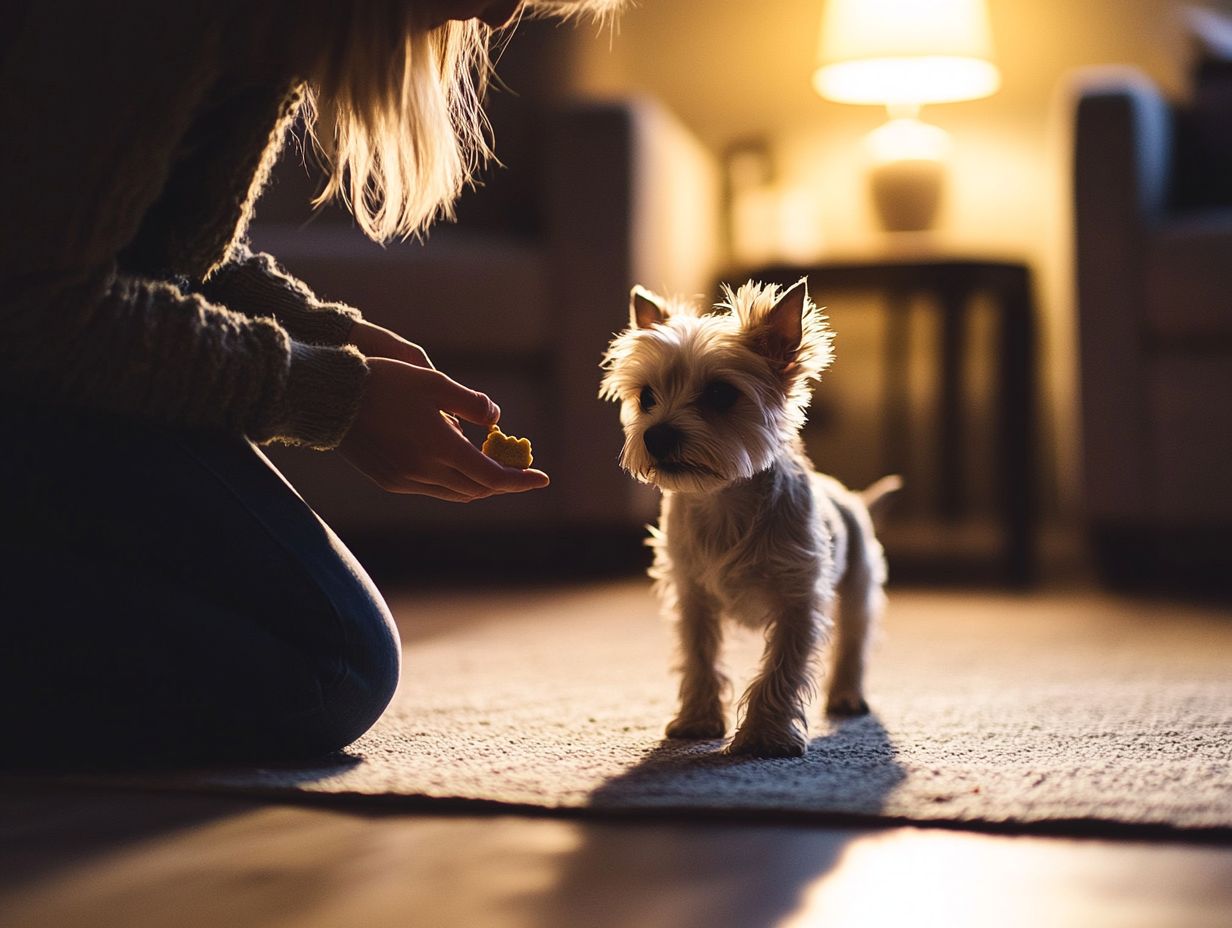
- Clicker training is a positive reinforcement technique that uses a distinct sound to mark desired behaviors in dogs.
- For anxious dogs, clicker training can effectively reduce anxiety and build positive associations with training.
- To successfully clicker train an anxious dog, it is important to prepare, use appropriate techniques, and address challenges as they arise.
Understanding Clicker Training
Understanding Clicker Training is vital for dog owners who want to implement positive reinforcement techniques with finesse. This method employs a sound that tells your dog they ve done something right the click sound to mark desired behaviors during training sessions, fostering a clear line of communication between you and your dog.
By embracing the principles of animal learning, clicker training can significantly enhance your training experience, yielding impressive results in behavior modification while strengthening the bond you share with your canine companion.
This learning process allows for the gradual development of obedience commands and encourages the use of effective training tools across various scenarios.
What is Clicker Training?
Clicker training is a contemporary approach to dog training that harnesses the power of positive reinforcement to inspire good behavior in your canine companion.
This method uses a small handheld device that produces a distinct clicking sound to mark the behaviors you want to encourage. This allows your dog to connect that sound with a reward usually a delicious treat.
Unlike traditional training approaches that depend on corrections and leash pulls, clicker training creates a more engaging and enjoyable experience for both you and your pet.
For instance, when you’re teaching your dog to sit, you click the moment they lower into position and then follow up with a tasty reward. This immediate feedback helps your dog grasp precisely which action is being rewarded, effectively reinforcing that behavior over time.
How Does it Work?
Clicker training is an effective approach that associates the distinct click sound with a positive reward, creating a conditioned reinforcer that signals desired behavior to your dog.
This method is rooted in a method where actions are rewarded or ignored, where behaviors are either strengthened or weakened based on the outcomes they produce.
The click sound serves as a precise marker, clearly indicating to your dog which behavior was correct at that moment. Timing is everything; the click should follow the desired action immediately to establish that crucial connection.
By consistently using the clicker during training sessions, you reinforce this bond, ensuring your dog understands that a reward is on the way whenever it hears that familiar sound.
Over time, this approach enhances learning, encouraging your dog to repeat those positive behaviors with enthusiasm.
Benefits of Clicker Training for Anxious Dogs
Clicker training presents a wealth of benefits for anxious dogs, and understanding leash training for anxious dogs offers a structured approach that relies on positive reinforcement to ease stress and cultivate a sense of security.
By utilizing training rewards thoughtfully, you can effectively tackle behavioral issues, shaping a calmer environment that encourages learning.
This method emphasizes rewarding desired behaviors instead of punishing unwanted ones, allowing anxious dogs to flourish while boosting their confidence and eagerness to participate in training sessions.
It promotes gradual behavior modification that unfolds over time.
Start clicker training your dog today for a happier, more confident companion!
Reducing Anxiety and Stress
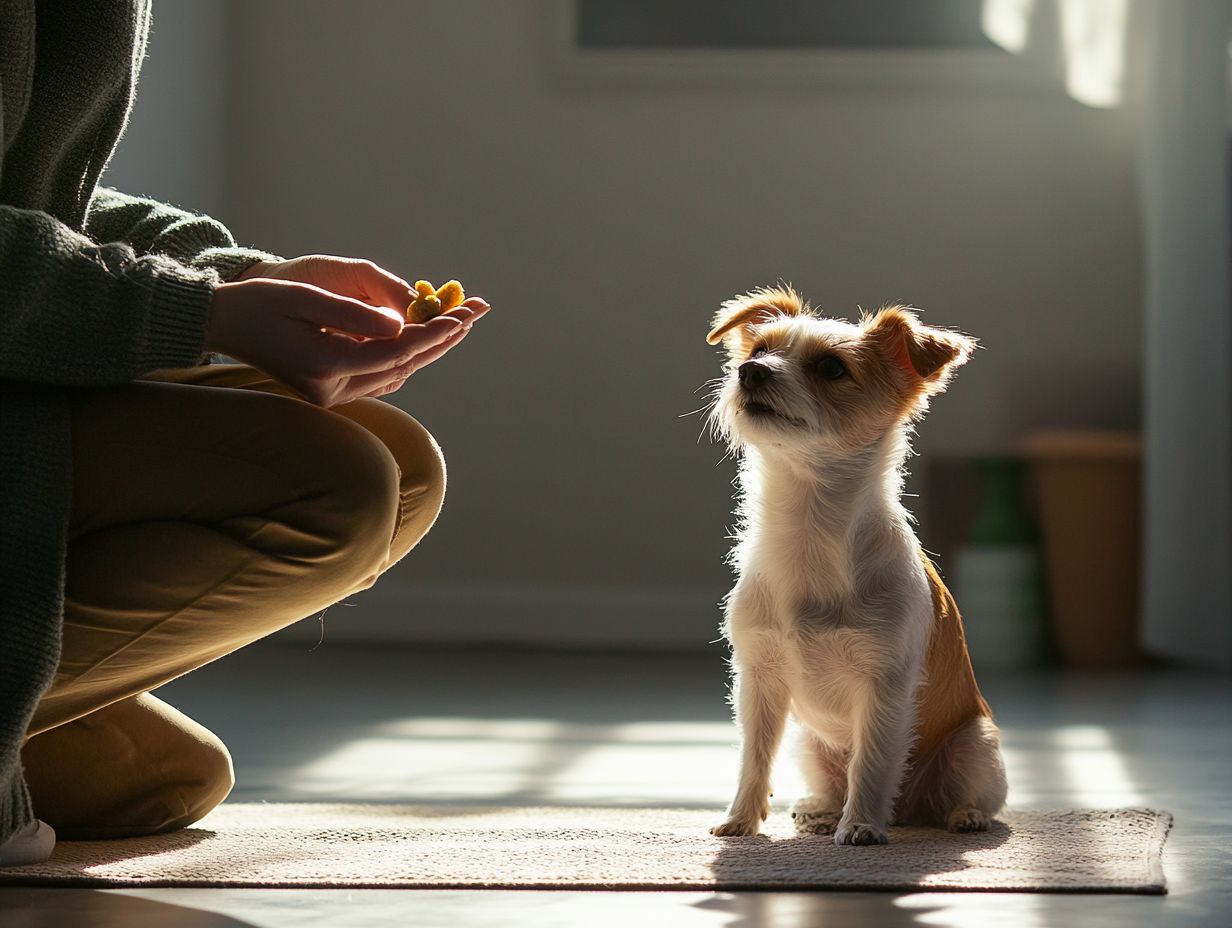
Clicker training is a powerful method to help anxious dogs feel calm. This training uses positive reinforcement and can be particularly effective, as outlined in using clicker training to alleviate anxiety, creating a safe space for your pet.
When your dog behaves calmly in stressful situations like meeting new people or enduring loud noises reward them promptly. This reinforces their positive experiences and helps them cope better over time.
Building Positive Associations
Creating positive associations is vital for anxious dogs who may have had negative experiences. Consistent training helps them link commands and environments with enjoyable outcomes.
The sound of the clicker acts as a bridge, connecting the desired behavior to rewards. This simplifies their understanding of what is expected from them.
As they face different stimuli, you ll see their confidence grow, leading to improved behavior over time. These ongoing training sessions enhance their ability to adapt and can change their perception of feared situations into opportunities for positive interaction.
Steps for Clicker Training an Anxious Dog
Training an anxious dog with clicker training requires careful planning. To ensure success, consider following tips for training an anxious dog in public and start by creating an ideal learning environment.
Establish a safe and serene space where your dog can feel secure during training sessions. This is crucial for their comfort.
By using effective techniques, you ll create a positive learning experience that helps your dog gradually build confidence and reduce anxiety. This method strengthens the bond between you and your furry companion.
Preparing for Training
Preparation is key for successful clicker training, especially for anxious dogs. Utilizing techniques for training anxious senior pets can provide the extra care they need.
Creating a calming atmosphere helps your dog feel at ease, as environmental factors can impact their focus. Gather essential tools like a clicker, treats, and a quiet space free from distractions.
Keep your training sessions brief but consistent, ideally lasting around 5 to 10 minutes. This keeps your dog engaged without feeling overwhelmed. Using treats as rewards boosts motivation, reinforces positive behavior, and strengthens your bond.
Clicker Training Techniques
You have many effective techniques at your disposal to help reinforce desired behaviors in anxious dogs.
Consider methods like shaping, luring, and targeting. Each offers a unique way to alleviate anxiety.
Shaping involves rewarding small steps towards the desired behavior, allowing your dog to build confidence at their own pace. Luring uses treats or toys to guide your dog into the desired action, capturing their attention and easing their uncertainty. Targeting teaches your dog to touch a specific item, fostering focus and serving as a calming exercise.
The consistent use of rewards is central to these techniques. This encourages good behavior while fostering a safe and positive training environment through effective positive reinforcement.
Troubleshooting Common Challenges

Navigating the common challenges of clicker training is crucial for dog owners, particularly when faced with fearful reactions or resistance to the process.
Understanding how to troubleshoot these issues can significantly enhance the training experience for both you and your dog.
Dealing with Fearful Reactions
Dealing with fearful reactions in dogs can be quite the challenge during your clicker training sessions. Understanding these reactions is essential, as they often arise from past experiences or sensitive temperaments.
It s important for you to recognize signs of anxiety, such as cowering, whining, or avoiding eye contact.
A strategic approach can significantly help in minimizing these fears through gradual exposure to the training environment. By slowly introducing new stimuli and pairing them with treats or praise, you can transform the training experience into a more positive one.
This positive reinforcement encourages your dog to associate things that scare them with rewards, gradually fostering a more confident demeanor.
Techniques like desensitization can be invaluable in effectively modifying their behavior, helping both you and your dog thrive during training.
Addressing Resistance to Training
Addressing resistance to training is vital for the success of the clicker training method.
You must recognize that some dogs may resist training due to fear, uncertainty, or simply feeling overwhelmed.
Anxiety might arise from previous negative experiences, environmental distractions, or even the training techniques being employed.
It s essential for you to identify these emotional barriers and adapt your approach accordingly. Gradually progressing through training tasks can help alleviate stress.
Starting with simpler commands and slowly increasing the difficulty can significantly build your dog s confidence.
By employing positive reinforcement techniques, such as treats or verbal praise, you can encourage your dog to engage willingly. This creates a more enjoyable training environment.
Stay patient! Your hard work will pay off! Consistency and encouragement will lead to meaningful improvement over time.
Incorporating Clicker Training into Daily Life
Get ready to elevate your training experience! Incorporating clicker training into your daily life can transform routine interactions into opportunities for growth and learning.
Using Clicker Training for Everyday Situations
Using clicker training in everyday situations allows you to reinforce positive behavior in real-time with your dog.
For instance, during walks, you can click and reward your furry companion when it calmly greets other dogs or ignores distractions.
This not only encourages desirable behavior in social settings but also enhances their overall demeanor.
Similarly, during playtime, employing the clicker when your dog retrieves a toy or performs a trick fosters motivation and engagement.
When introducing new people, clicking and rewarding your dog for calm behavior helps them associate newcomers with positive experiences.
These examples clearly illustrate that using training rewards such as treats or praise not only strengthens the bond between you and your pet but also underscores the vital role of positive reinforcement in daily life.
Try these techniques today and watch your dog’s confidence soar!
Maintaining Progress and Positive Behaviors

Maintaining progress and positive behaviors is essential for your long-term success in clicker training.
Establish a routine of regular training sessions to reinforce the skills you’ve learned.
Consistency is key; it helps you retain information and keeps you engaged and responsive to cues.
Focus on reinforcing good behavior instead of merely correcting mistakes. This approach can strengthen your bond and ignite enthusiasm for learning.
As circumstances change or new challenges arise, adapting your techniques and introducing fresh exercises can keep your training exciting.
This ensures that the gains you’ve made are not only preserved but also built upon over time.
This exciting approach builds a supportive environment where your dog can thrive!
Frequently Asked Questions
What is clicker training and how can it help my anxious dog?
Clicker training is a positive reinforcement technique that uses a clicker to mark desired behaviors and reward them with treats.
It can help anxious dogs by teaching them new behaviors and helping them associate positive experiences with certain situations.
How do I start clicker training my anxious dog?
To start clicker training your anxious dog, you will need a clicker, treats, and a quiet, calm environment. For effective strategies, consider exploring tips for training anxious pets at home.
Begin by teaching your dog to associate the clicker with a treat by clicking and treating repeatedly.
Then, use the clicker to mark and reward desired behaviors.
Can clicker training be used to calm an anxious dog during a stressful situation?
Yes, clicker training can help calm an anxious dog during stressful situations.
By teaching your dog to associate the clicker with positive experiences, you can use it to redirect their attention and reinforce calm behaviors. For training techniques specifically for anxious breeds, consider incorporating these methods into your routine.
What are some common mistakes to avoid when using clicker training for anxious dogs?
One common mistake to avoid is using the clicker as punishment or using it too harshly.
This can cause your dog to become more anxious and fearful of the clicker.
It’s also important to use high-value treats and not expect too much progress too quickly.
How can I use clicker training to help my anxious dog overcome their fears?
Clicker training can help your anxious dog overcome their fears by gradually exposing them to fear-inducing stimuli in a controlled way, and learning how to use rewards to train anxious pets can enhance this process.
Start by introducing the fear-inducing stimulus at a distance and click and treat when your dog remains calm.
Slowly decrease the distance over time as your dog becomes more comfortable.
Is clicker training suitable for all types of anxious dogs?
While clicker training can be effective for many anxious dogs, it may not be suitable for all types or levels of anxiety. To better understand how to address these issues, exploring the science behind training anxious pets can provide valuable insights.
If your dog’s anxiety is severe, it’s best to seek the help of a professional trainer or behaviorist who can provide personalized training techniques for your dog’s specific needs.
Start your journey today with clicker training and see the transformation in your furry friend!

